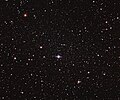File:Carina Dwarf Galaxy.jpg

Alkuperäinen tiedosto (3 771 × 3 145 kuvapistettä, 5,64 MiB, MIME-tyyppi: image/jpeg)
Kuvatekstit
Kuvatekstit
Yhteenveto[muokkaa]
| KuvausCarina Dwarf Galaxy.jpg |
English: It’s one of the closest galaxies to Earth, but the Carina Dwarf Galaxy is so dim and diffuse that astronomers only discovered it in the 1970s. A companion galaxy of the Milky Way, this ball of stars shares features with both globular star clusters and much larger galaxies.
Astronomers believe that dwarf spheroidal galaxies like the Carina Dwarf are very common in the Universe, but they are extremely difficult to observe. Their faintness and low star density mean that it is easy to simply see right through them. In this image, the Carina Dwarf appears as many faint stars scattered across most of the central part of the picture. It is hard to tell apart stars from the dwarf galaxy, foreground stars within the Milky Way and even faraway galaxies that poke through the gaps: the Carina Dwarf is a master of cosmic camouflage. The Carina Dwarf’s stars show an unusual spread of ages. They appear to have formed in a series of bursts, with quiet periods lasting several billion years in between them. It lies around 300 000 light-years from Earth, which places it further away than the Magellanic Clouds (the nearest galaxies to the Milky Way), but significantly closer to us than the Andromeda Galaxy, the closest spiral galaxy. So, despite being small for a galaxy, its proximity to Earth means that the Carina Dwarf appears quite large in the sky, just under half the size of the full Moon — albeit very much fainter. This makes it fit comfortably within the field of view of ESO’s Wide Field Imager, an instrument designed for making observations of large parts of the sky. Although this image in itself is not so striking, it is likely the best image of the Carina Dwarf Galaxy to date. The image was made using observations from the Wide Field Imager on the MPG/ESO 2.2-metre telescope at La Silla, and from the Victor M. Blanco 4-metre telescope at the Cerro Tololo Inter-American Observatory. |
| Päiväys | |
| Lähde | http://www.eso.org/public/images/potw1126a/ |
| Tekijä | ESO/G. Bono & CTIO |
Lisenssi[muokkaa]
- Voit:
- jakaa – kopioida, levittää ja esittää teosta
- remiksata – valmistaa muutettuja teoksia
- Seuraavilla ehdoilla:
- nimeäminen – Sinun on mainittava lähde asianmukaisesti, tarjottava linkki lisenssiin sekä merkittävä, mikäli olet tehnyt muutoksia. Voit tehdä yllä olevan millä tahansa kohtuullisella tavalla, mutta et siten, että annat ymmärtää lisenssinantajan suosittelevan sinua tai teoksen käyttöäsi.
Tiedoston historia
Päiväystä napsauttamalla näet, millainen tiedosto oli kyseisellä hetkellä.
| Päiväys | Pienoiskuva | Koko | Käyttäjä | Kommentti | |
|---|---|---|---|---|---|
| nykyinen | 24. helmikuuta 2015 kello 13.14 |  | 3 771 × 3 145 (5,64 MiB) | FDMS4 (keskustelu | muokkaukset) | Reverted to version as of 14:03, 28 June 2011. |
| 24. helmikuuta 2015 kello 03.00 |  | 3 768 × 3 144 (5,78 MiB) | SteinsplitterBot (keskustelu | muokkaukset) | Bot: Image rotated by 180° | |
| 28. kesäkuuta 2011 kello 14.03 |  | 3 771 × 3 145 (5,64 MiB) | Jmencisom (keskustelu | muokkaukset) |
Et voi tallentaa uutta tiedostoa tämän tilalle.
Tiedoston käyttö
Seuraava sivu käyttää tätä tiedostoa:
Tiedoston järjestelmänlaajuinen käyttö
Seuraavat muut wikit käyttävät tätä tiedostoa:
- Käyttö kohteessa af.wikipedia.org
- Käyttö kohteessa ar.wikipedia.org
- Käyttö kohteessa ast.wikipedia.org
- Käyttö kohteessa ca.wikipedia.org
- Käyttö kohteessa de.wikipedia.org
- Käyttö kohteessa el.wikipedia.org
- Käyttö kohteessa en.wikipedia.org
- Käyttö kohteessa es.wikipedia.org
- Käyttö kohteessa fi.wikipedia.org
- Käyttö kohteessa fr.wikipedia.org
- Käyttö kohteessa he.wikipedia.org
- Käyttö kohteessa id.wikipedia.org
- Käyttö kohteessa it.wikipedia.org
- Käyttö kohteessa ja.wikipedia.org
- Käyttö kohteessa ko.wikipedia.org
- Käyttö kohteessa mk.wikipedia.org
- Käyttö kohteessa nl.wikipedia.org
- Käyttö kohteessa no.wikipedia.org
- Käyttö kohteessa pl.wikipedia.org
- Käyttö kohteessa pt.wikipedia.org
- Käyttö kohteessa ro.wikipedia.org
- Käyttö kohteessa ru.wikipedia.org
- Käyttö kohteessa si.wikipedia.org
- Käyttö kohteessa sk.wikipedia.org
- Käyttö kohteessa tr.wikipedia.org
- Käyttö kohteessa uk.wikipedia.org
- Käyttö kohteessa vi.wikipedia.org
- Käyttö kohteessa www.wikidata.org
Metatieto
Tämä tiedosto sisältää esimerkiksi kuvanlukijan, digikameran tai kuvankäsittelyohjelman lisäämiä lisätietoja. Kaikki tiedot eivät enää välttämättä vastaa todellisuutta, jos kuvaa on muokattu sen alkuperäisen luonnin jälkeen.
| Verkossa oleva tekijänoikeustieto | |
|---|---|
| Tekijä/toimittaja | ESO/G. Bono & CTIO |
| Lähde | European Southern Observatory |
| Lyhyt otsikko |
|
| Kuvan nimi |
|
| Luontipäivämäärä | 27. kesäkuuta 2011 kello 10.00 |
| Tekijänoikeudellinen tila | Tekijänoikeustiedot puuttuvat |
| Avainsanat | Carina Dwarf Galaxy |
| Yhteystiedot |
Karl-Schwarzschild-Strasse 2 Garching bei München, , D-85748 Germany |